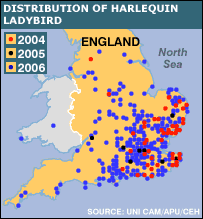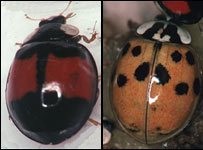- Tends to be rounder in shape than most native UK species
- Can reach up to 8mm in size, a little larger than common ladybirds
- It has a white plate just behind the head with a big, black M-shaped marking on it
- Sighted bugs can be red, orange or black with between 15 and 20 spots
Others may be black with between two to four orange or red spots
I was at a bit of a loss as to what to write about today. Tsk. All the internets at my command, and I got nuthin’. It’s not just me: there seems to be a bit of a hiatus in the blog world generally at the moment, a collective holding of breath.
Are we waiting for the next big media outrage, or is there really no news? well, hardly – there’s Iraq, of course (we’ll always have Iraq), there’s the US attorneys diversionary scandal, there’s constitutional shenanigans, deliberate leaks re terrorism arrests, and yet more government IT incompetence at home in the UK – and then there’s the US pushing illegal war again, this time in the Horn of Africa. Oh yes, and let’s not forget that dreamboat Wolfowitz. There’s no shortage of material to provoke online outrage. So why am I writing about ladybirds?
For the past two weeks it’s been gloriously sunny and in the twenties every day: everything is in bloom, the birds are singing en masse, summer finery has broken out in the streets and there’s been a run on fake tanning lotion and Birkenstocks. Really, all I want to do is sit outside in the sun with a Margery Allingham and bask until my freckles join up enough to give the semblance of a suntan, occasionally getting up to attack the garden with a spray of soapy water. Because in every idyll there’s a hidden flaw, and for me it’s the greenfly that have infested the damson tree outside and not only because they eat my new, little, tender plants.
We’re having a full-on greenfly infestation – the trunk of the damson tree looks like a five-lane arthropod highway, with aphids streaming en masse down the trunk – and there seem to be no predators about to eat them. My back garden and everything in it is being subjected to a fine rain of sticky honeydew from the uneaten greenfly and when you go out there, you can feel your feet stick to the flagstones. They fall in your hair and on the laundry, leaving green smears where you flick them away. Eww.
Normally a glut of greenfly like this would attract their chief predator, ladybirds. Last year we had a similar infestation, that time of ladybird larvae – the ugly little yellow spiky buggers were falling everywhere, in the cats’ food, on the laundry, and in my tea if I sat outside – but this year, not one’s to be seen. No ants either, although we have or had at least two ant nests in the garden. I can only infer that the current glut of greenfly is due to the absence of natural predators.
So where the hell are they?
The absence of bees has already been remarked in Europe; apart from a couple of queens I saw at the end of January, the only ones I’ve seen were two dying bees that wandered into the house accidentally a month ago. This despite a mass of blossom and spring flowers that should be humming with them. But it seems it’s not just bees; missing ladybirds are a Europe-wide problem too. The Independent has one possible explanation for their disappearance:
British ladybirds face rapid extinction after invasion by an Asian interloper By Jonathan Brown and Michael McCarthy
Published: 27 December 2005They have a special place in the hearts of children. They’re beloved by gardeners as natural pest controllers. But say goodbye to Britain’s ladybirds, many of which are now facing extinction within a few short years.
In what is probably the worst case of havoc caused by an invasive species the UK has ever seen, a whole group of British ladybird species is likely to be wiped in short order out by an aggressive foreign interloper, which will also become a major pest.
Harmonia axyridis, the harlequin ladybird from Asia, was first detected in Britain in September last year and known to be a threat to familiar species of our own such as the two-spot and the seven-spot ladybirds, by outcompeting them for the aphids on which they feed – and also by eating them directly.
But scientists have recently realised it is having an effect more quickly than anticipated. Those shiny bright red beetles with their black spots, which generations of children have delighted in, and which gardeners have so long relied on to deal with the aphids (greenfly) eating their roses, will soon be a thing of the past.
Britain’s leading ladybird expert, Michael Majerus from Cambridge University, says the harlequin, which has come into Britain from continental Europe, either in flower or vegetable imports, or by flying in directly, poses a dire threat to half of Britain’s 46 species. He thinks most of the country will be overrun by 2008, and native species will start to disappear immediately.
Although other non-native species have caused severe problems with British wildlife – for example, the grey squirrel from North America has driven out the native red squirrel – Britain has not so far seen a foreign invader destroy a whole suite of other species, as the harlequin is now likely to do.
“In ecological terms, this is a disaster,” Dr Majerus said. “I don’t know of a worse one.”
[..]
They were also introduced into Belgium and by 2000 had become a danger in the Netherlands too. And we clever humans, masters of nature, did it. Doesn’t it make you proud?
You know, I could spend all day taking cynical snarky potshots at the walking human disasters we’ve been afflicted with over the past ten years or so, it’s just so easy to do. How can you not, when you have the likes of Laura Bush, bleating through her valium haze that ‘no-one has suffered as much’ over Iraq as she and her husband have?
But while we snark away, lots of small ecological disasters accumulate.

A plague of aphids is irritating and the disappearance of ladybirds, ants and bees is an annoyance in a tiny, manicured city garden like ours; but this isn’t just about the inconvenience to vanity gardeners like me. This disappearance of common native species is about the way tiny changes instigated by well-meaning humans can have a disastrous effect on whole ecological systems. Add global warming to this human meddling and it starts to affect major food crops.
Greenfly: less an irritation, more a pending humanitarian crisis.
[*Lieveheersbeestje: the Dutch word for ladybird/ladybug: it means ‘the dear lord’s little creature’. Awww. There’s much more about ladbybirds and the wildlife of Dutch/Belgian gardens from Michel Vuijlsteke, here]
